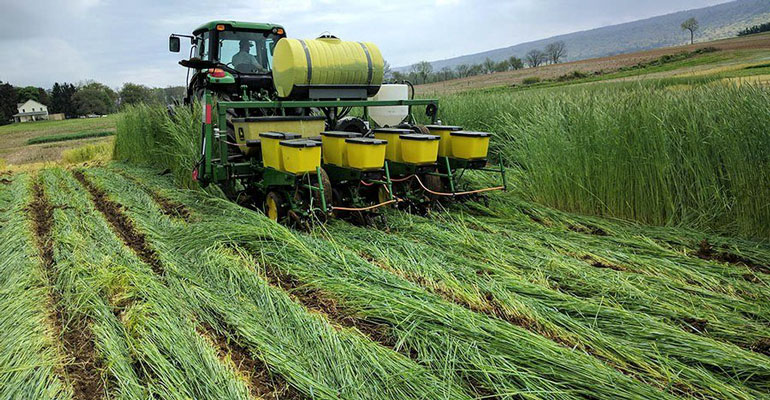May 18, 2020

Excess moisture, plus cool temperatures in April have delayed field work, including planned cover crop burndowns. Meanwhile, cover crops continue to grow, with rye heads emerging and crimson clover starting to bloom in the southeast part of the state.
Those who did have the chance to burn down cover crops may notice the dead residue insulating the soil. While this is excellent for soil conservation, it also traps excess moisture and slows evaporation, so soil takes longer to dry for corn and soybean planting.
With the optimum planting window shrinking fast, this could be a good year for planting green.
Penn State research has shown that planting green into living cover crops provides a significantly drier seed bed compared to planting into cover crops killed a week or more preplant. Allowing the cover crops to grow until main crop planting means they continue to transpire, drawing water from the root zone and drying the soil.
Planting green can also conserve more moisture later in the growing season compared to preplant killed cover crops due to the higher biomass residue trapping moisture. This can be beneficial to crops during summer dry spells.
Is there a risk of soil temperatures being too cool if you plant directly into cover crops? Not necessarily. Heidi Reed, a Penn State agronomy Extension agent, says that in data she has accumulated where soil temperatures were measured to 3 inches deep for four hours at a time, the daily fluctuation in soil temps was actually lower in fields planted green — highs were lower and the lows were higher — due to the biomass insulating the soil.
As with any new management practice, it is best to do some homework before using it on all your acres.
Here are some suggestions based on a three-year study if you haven’t planted yet and are considering planting green:
1. Plant green with soybeans first. Soybeans adapt to reduced populations from residue interference and cooler soils by branching. Corn, on the other hand, doesn’t adapt well to reduced populations. Additionally, slowed release of nitrogen tied up in the cover crop due to high carbon-to-nitrogen-mature cover crops and cooler soil is not a concern for soybeans.
2. Watch what your equipment can handle. Although every farmer uses different equipment and settings for planting green and management varies from farm to farm, all equipment should be well-maintained and calibrated.
It is recommended to roll cover crops taller than 18 inches to reduce cover crop residue interference with the main crop.
3. Using aggressive row cleaners. This is often a matter of preference, but those new to the practice may appreciate more aggressive residue management for better sunlight penetration to help warm the furrow and improve emergence.
4. Use a planter for soybeans. Greater precision with planters improves soybean performance compared to drills when we planted green.
5. Focus on optimum planting depth. You’re going to be planting through significantly more biomass than usual. Make sure to adjust gauge wheels to account for the thickness of the extra residue.
6. Watch nitrogen management. To make sure corn doesn’t suffer from the slow release of nitrogen, an extra 50 pounds per acre of nitrogen at planting is recommended, with the remainder of nitrogen applied at side-dress based on yield goals.
A PSNT test and tissue sampling can help dial in your nitrogen needs.
7. Scout for pests. Scouting for pests and using integrated pest management practices are always considered best practices.
8. Avoid neonicotinoid seed treatments. Preemptive insecticide spraying can kill predators of insects and slug pests, which are allies in pest control.
Some farmers have found that planting green reduces slug damage to their main crops. We have found that reduced slug damage was not predictable in soybeans and found mixed results for corn but promoting natural enemies has been shown in other studies to significantly reduce pests.
9. Consult with other farmers. It’s always best to learn from those nearby with similar soils and crop rotations who have planted green successfully. Don’t be afraid to ask questions and learn from others’ mistakes.
Source: Penn State Cooperative Extension, which is solely responsible for the information provided and is wholly owned by the source. Informa Business Media and all its subsidiaries are not responsible for any of the content contained in this information asset.
You May Also Like




